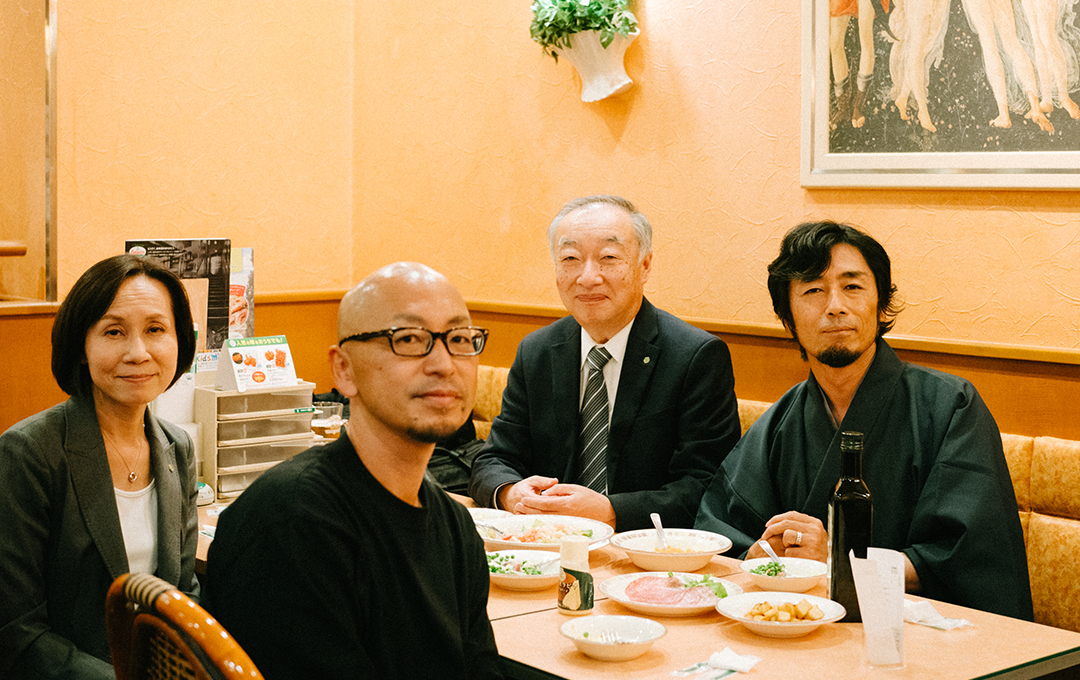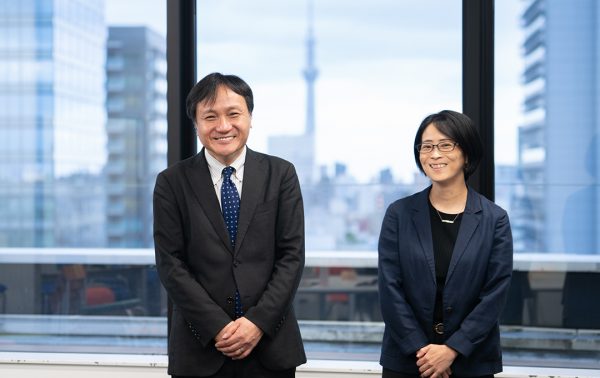Outline
全国にイタリアンレストランを展開する株式会社サイゼリヤ(以下、サイゼリヤ)は、理工学部人間総合理工学科の檀 一平太教授との共同研究の中で消費者の心理を数値化、モデル化して、ブランド展開やメニュー開発に活用しています。2011年以降続いている共同研究のきっかけや、連携関係が長く続いている理由などについて、サイゼリヤ研究開発部の小川豊部長(取材当時)と檀教授がプロジェクトを振り返りました。
The national Italian restaurant chain Saizeriya Co. has collaborated with Prof. Ippeita Dan of the Department of Integrated Science and Engineering for Sustainable Society, Faculty of Science and Engineering, Chuo University to quantify and model consumer sentiment in such a way that the findings can be used for brand development and menu creation. In this interview, Yutaka Ogawa, the then Director of Research and Development at Saizeriya, and Prof. Dan reflect on the project and discuss topics such as how the joint research effort began in 2011 and how the partnership has lasted so long.

檀 一平太
理工学部 人間総合理工学科 教授
1969年生まれ。国際基督教大学教養学部理学科生物学専攻卒業。東京大学大学院総合文化研究科博士課程中退。日本学術振興会特別研究員、科学技術振興事業団研究員、健康食品会社営業員等を経て、食品総合研究所に入所。PD、研究員、 主任研究員、自治医科大学医学部先端医療 技術開発センター准教授を経て、現在、中央大学理工学部人間総合理工学科教授。学術博士。
Ippeita Dan
Professor, Faculty of Science and Engineering, Chuo University
Born in 1969. Graduated from the Department of Biology, Faculty of Liberal Arts, International Christian University. Withdrew from the doctoral course at the Graduate School of Arts and Sciences, the University of Tokyo. After working as a researcher for the Japan Society for the Promotion of Science (JSPS), a researcher for the Japan Science and Technology Agency (JST), and a salesperson for a health food company, he joined the National Food Research Institute. Professor, Department of Human Rational Engineering, Faculty of Science and Engineering, Chuo University. He is currently a professor at the Department of Human Science and Engineering, Faculty of Science and Engineering, Chuo University.

小川 豊
株式会社サイゼリヤ 研究開発部 部長(取材時)
Yutaka Ogawa
Manager, Research & Development Department, Saizeriya Corporation (at the time of interview)
ノープランで相談にいっても研究を提案いただき、方向性が見えた
A meeting that started with no plan ended with a research proposal and a vision for a way forward
——小川さんが檀先生に連絡をとった理由を教えてください。
Q: Mr. Ogawa, please tell us why you contacted Prof. Dan.
小川部長(以下、敬称略):2011年に社長直轄の研究開発部が立ち上がったのがきっかけです。外食企業で研究開発部があるところは今でも珍しいと思いますが、最初は私1人だけで、社長からは「何をやってもいい」と言われました。
Ogawa: Our company established the Department of Research and Development in 2011 under the direct supervision of the company president. Even today it is unusual for a restaurant chain to have an R&D department. At first, I was on my own and our president told me, “You can do whatever you want.”
そのときに考えたのが、アンケート調査です。2008年にサイゼリヤに入社する前は飲料メーカーにいたのですが、商品開発のときにアンケート調査を行っても、同じ条件でも結果が違うことが多くあります。膨大なお金をかけている割には、お客様の本音をつかめていないのではないかと疑問に思っていました。
The first thing I thought of was a questionnaire survey. Before joining Saizeriya in 2008, I was at a beverage manufacturing company. When we conducted questionnaire surveys for product development, we would often get different results even under the same conditions. For all the money we were spending, I had doubts about our ability to understand the customers’ true feelings.
サイゼリヤは国内に1000店舗以上あり、お越しになられるお客様の総数は1年間で1億5000万人にも上ります。ところが、お客様のことを全然わかっていないのではないかという印象が、この会社に来たときからずっとありました。
Saizeriya operates more than 1,000 restaurants in Japan, with 150 million customers per year. However, after joining the company, I had the feeling that the company doesn’t understand its customers.
そこで、お客様の本音を知るための新しい技術について考え、ウェブサイトや論文検索サイトで心理学や脳科学に関する論文を調べました。その中でたどり着いたのが檀先生です。農研機構の食品総合研究所にいたとのことで、テーマも近いために相談しました。ただ、そのときは、「具体的にこの方法でやりたい」とは考えておらず、白紙の状態でお話を聞きに行きました。
Therefore, I started thinking about new techniques that could be used to understand customers’ true feelings. I began searching for journal articles on psychology and neuroscience using such websites as academic databases. During this process, I came across Prof. Dan. He was conducting research on similar themes at the National Food Research Institute, which was part of the National Agriculture and Food Research Organization, so I got in touch. However, at that time I didn’t have a specific idea of what I wanted to do, so I went into the conversation as a blank slate.
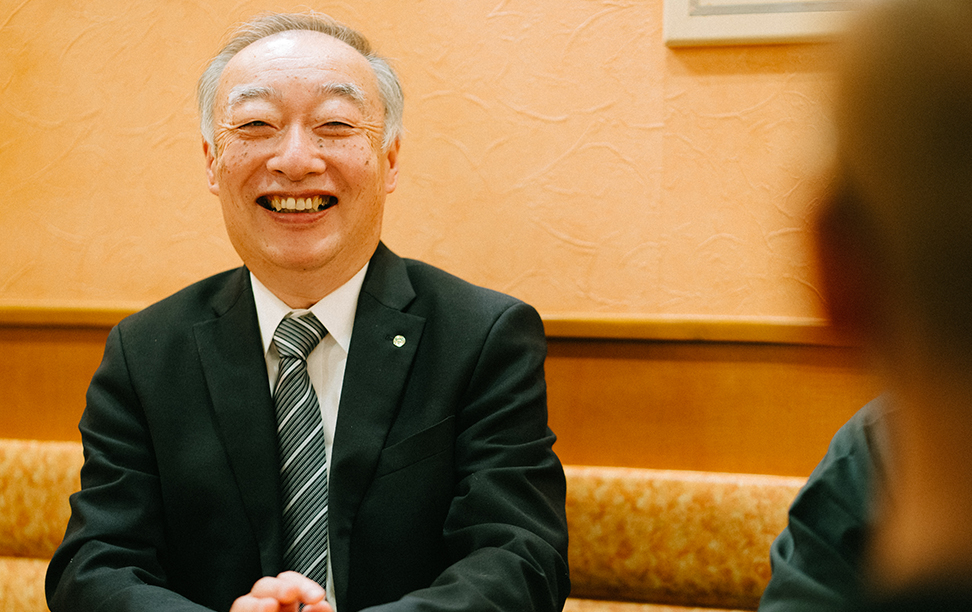
——檀先生は、最初どのようなお話をしましたか?
Q: Prof. Dan, what kind of topics did you discuss at first?
檀:脳の研究をしていると言うと、「美味しさがわかる」などの印象をもたれるかもしれませんが、そうではありません。我々の研究室では、人の心理の流れを追う「サイコメトリクス(心理計量学)」という学問を専門としています。今回のお話であれば、お客様がサイゼリヤや商品に対してどのような認知構造をもって好きになるのか、お客様の頭の中の構造を可視化します。その流れをサービスや製品の向上につなげられると小川さんに提案しました。
Dan: When I tell people that I’m studying the brain, they sometimes have the impression that it involves things like “understanding delicious flavors,” but that’s not the case. Our laboratory specializes in the discipline of “psychometrics,” which follows the flow of human psychology. With regards to the present topic, we wanted to identify the cognitive structures customers have when they start to like Saizeriya or its products, and to visualize the pertinent structures in customers’ brains. I proposed to Mr. Ogawa that this flow could be linked to improving services and products.
小川:当時はニューロマーケティングという言葉が流行っていたので、我々も脳の分析で何かできそうと考えていました。それに対して檀先生は丁寧な資料を作っていただき、「脳でわかるのはここまでです、サイコメトリクスならこれがわかります」と、今までの研究も含めてご説明いただきました。私も、サイコメトリクスのほうがよさそうということで、サイコメトリクスを主軸にスタートしました。
Ogawa: At the time, the term “neuromarketing” was trendy, and we had also thought about doing something with brain analysis. Prof. Dan gathered a comprehensive set of materials that included previously conducted research on this topic. He explained to us that “You will be able to find out up to this point by analyzing the brain, but with psychometrics you will be able to understand this much.” I was also thinking that psychometrics seemed like a better approach, so I had started with it as our main axis.
檀:共同研究が始まったのは私が前の大学にいたときですが、私が中央大学に移るときに研究開発機構の研究ユニット「サイゼリヤ食認知科学研究ユニット」を設置して、今に至ります。
Dan: The joint research project started when I was at my previous university, but when I moved to Chuo University, I set up the “Saizeriya Food Cognitive Science Research Unit” under our R&D organization, which has continued up to today.
※中央大学研究開発機構では「研究ユニット」を設置して学外資金を原資にした大型研究を行うことができる制度があります。
* The Chuo University R&D organization has a “research unit” system that allows large research projects to be carried out using funding from sources outside the university.
メニューや内装の魅力を数値で証明できるサイコメトリクス
Psychometrics can numerically verify the attractiveness of menus and interior designs
——檀先生の専門であるサイコメトリクスについて教えてください。
Q: Prof. Dan, please tell us about your specialty, psychometrics.
檀:サイコメトリクスとは、「心の物差し」を作り、「心を測る」ことです。心の物差しは「心理尺度」というもので、複数の質問から心を測ります。
Dan: Psychometrics is the creation of what can be called “yardsticks of the mind” that can be used to measure the mind. These yardsticks of the mind are “psychological scales” that use multiple questions to take measurements of the mind.
例えば、質問1つに対して5段階評価で答えると、離散変数といって連続した数として扱いにくくなります。そこで、関連する質問を5つ設けると、5×5=25という連続変数として扱えるようになります。
For example, if a single question is answered with a 5-point scale, this is called a “discrete variable,” which is difficult to treat as a continuous value. But if you create 5 related questions, you get 5 × 5 = 25, which can be treated as a continuous variable.

——1つの質問に25点満点で答えるのとは違うのですか?
Q: How is that different from answering one question worth a maximum of 25 points?
その方法で、17点と18点を厳密に区別できる人はいません。巧妙に質問を組み合わせることで、正確に人の心を測ることができるのです。質問は約100問、心理尺度は20くらい作ります。そして、多変量解析や構造方程式モデルといった高度な統計手法で、心の中にある認知の流れを定量化・可視化します。
With that method, it’s impossible to make a strict distinction between 17 points and 18 points. But by skillfully combining questions, it is possible to accurately measure a person’s mind. We have about 100 questions and have created about 20 psychological scales. This makes it possible to use advanced statistical methods like multivariate analysis and structural equation models to quantify and visualize the cognitive flow of the mind.
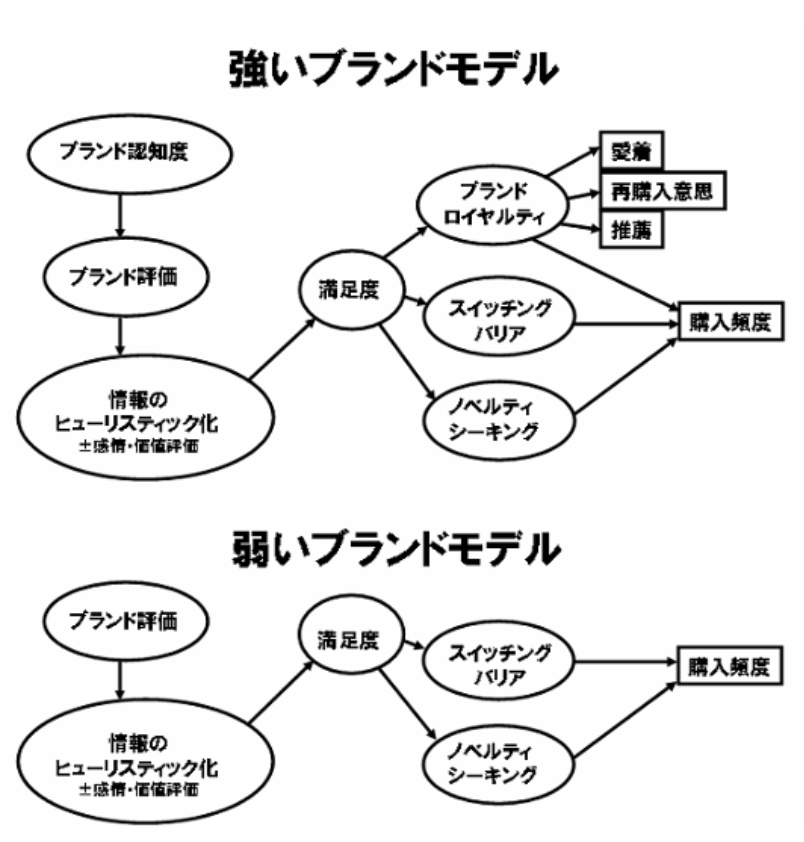
こうして、ブランドロイヤルティや購入頻度への流れを可視化できる。
Examples of visualizing the strength of a brand. Psychological scales (in this case on things like brand awareness, satisfaction, etc.) are created from multiple questions to quantify how strongly the psychological scales relate to each other. This enables visualization of the flow toward brand loyalty or purchase frequency.
小川:言うのは簡単ですが作るのは難しかったです。質問文は英語の文献をもとに作りますが、ニュアンスを残したまま翻訳するなど苦労がありました。
Ogawa: It’s easy to describe, but difficult to do. The questions were developed based on English-language articles, and we had a hard time translating them so that the nuance was preserved.
檀:一つひとつの心理尺度の精度も重要です。安定した測定ができるかという信頼性と、測りたい概念が本当に測れているかと言う妥当性が保証されたものだけを使います。
Dan: The accuracy of each psychological scale is also important. We only want to use scales that have “reliability,” which means the measurements are stable, as well as “validity,” which means the scale is actually measuring the concepts you want to measure.
小川:最初にやったのは、顧客ロイヤルティ(ブランドに対する信頼や愛着)を調べ、サイゼリヤにどのような魅力を感じ、何のために来店するのかを明らかにすることでした。
Ogawa: The first thing we did was to examine customer loyalty (brand trust and affection) to find out what appealed to people about Saizeriya and why they came to the stores.
——その結果、わかったことは何でしたか?
Q: What did you find out?
小川:お客様がサイゼリヤにお越しいただく最大の理由は、メニューだとわかりました。お客様が来店して、メニューを見てワクワクする、コストパフォーマンスがいいと感じて顧客ロイヤルティが上がるという構造が見事に可視化されたのです。
Ogawa: We found that the biggest reason customers come to Saizeriya is the menu. We were able to beautifully visualize a structure in which customers come to the restaurant excited to look at the menu, and when they get good cost performance, it increases their sense of loyalty.
小川:それを会長や社長に報告したら、「小川くん、これはすごいね」と言ってくれました。というのも、会長は常に、「サイゼリヤにお客様がいらっしゃる理由はたった一つ、メニューだ」と言い続けてきたからです。当たり前だと思っていたことが、檀先生との研究で改めて証明されたのです。
Ogawa: When I reported this to our chairman and president, they said, “Ogawa my boy, this is amazing.” The chairman had always said, “The only reason customers come to Saizeriya is the menu.” The things we took for granted were verified in our research with Prof. Dan.
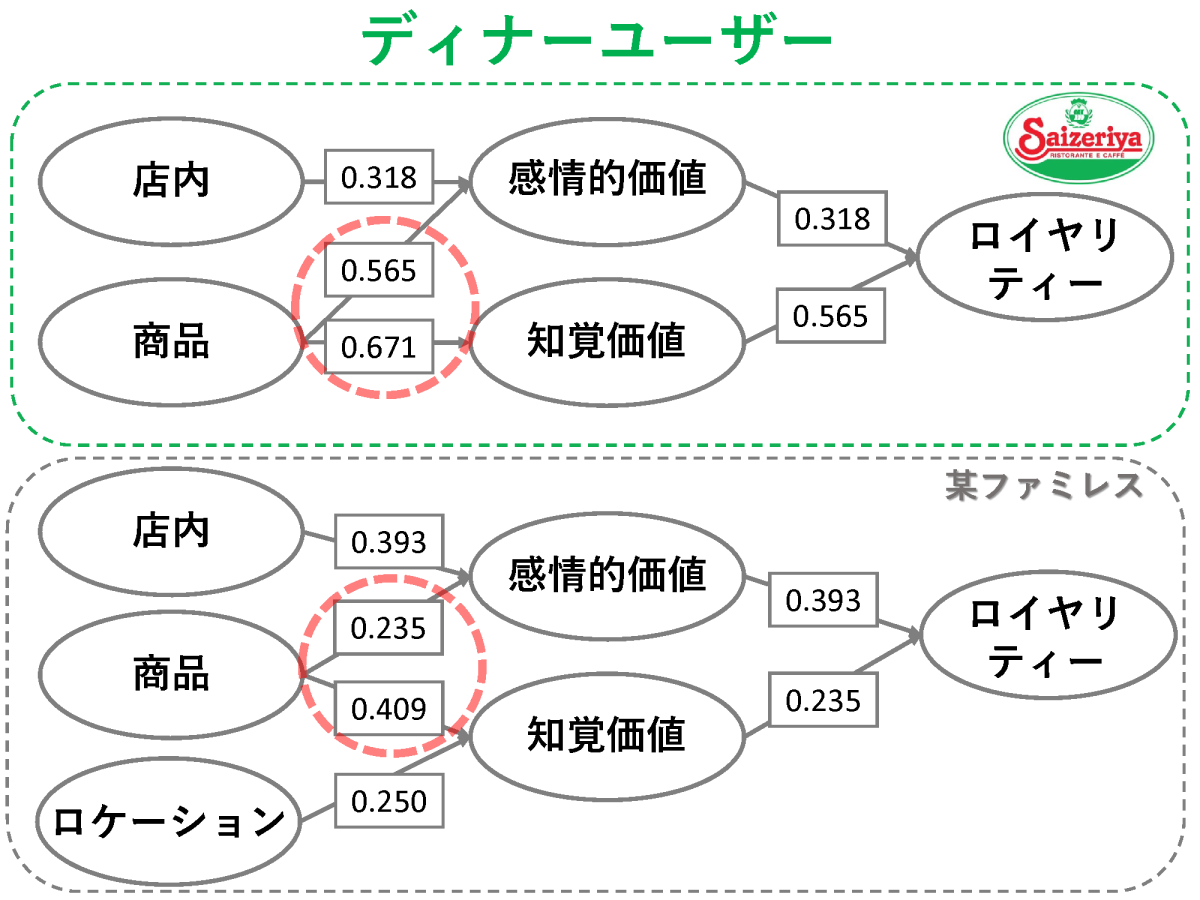
成功事例が1つできれば、あとは考え方を応用するだけです。次は個々の商品について調べました。ミラノ風ドリアを注文するお客様は何を考えて最後に何を感じるのか、ハンバーグやサラダの場合はどうかなど、先ほどの心理尺度を測る質問で、レストランを各商品に置き換えて調査しました。
Once you have a success story, all you have to do is put your ideas to work. Next, we started investigating our products. We investigated the menu by replacing restaurants with various items in the aforementioned psychological scale questions, such as what customers who ordered Milanese rice casserole were thinking and how they felt afterward. Then we did the same with items like hamburg steak and salad.
——メニュー以外にも活用できるのですか?
Q: Can you use these techniques for other things besides menu items?
檀:内装を変えるときにも活用しました。イタリアのデザイナーに依頼して、新しく「地中海的な明るさ」を出したいということだったのですが、顧客ロイヤルティがどうなるかというところがポイントでした。
Dan: We also used them when changing the interior design. Saizeriya wanted to have an Italian designer create a new “bright Mediterranean” look, but it was important to pay attention to the effects on customer loyalty.
改装前と後のデザイン案のCGを見比べて調べた結果、「イタリアらしさ」「会話のしやすさ」は上がった一方で、最終的な顧客ロイヤルティはほとんど変わらないことがわかりました。つまり、従来のお客様からの反発は起こらずに、押さえたいところは押さえた改装になると結論づけることができました。
When we compared the interiors before renovation to computer graphics of the proposed design, we found that while people thought the new design looked more Italian and would facilitate conversation, customer loyalty ultimately did not change much. In other words, we concluded that the redesign would allow Saizeriya to control the things it wanted to control, while not generating any backlash from its current customers.
小川:従来のアンケート形式では同じ条件でも結果が変わることがあったのですが、サイコメトリクスに基づくアンケートは結果が安定しており、再現性がとても高いんですよ。以前から疑問に感じていた「アンケート調査の結果が不安定」という課題が一気に解決された気分です。2020年からの新型コロナウイルス感染症の中でも、顧客ロイヤルティはあまり変わっていないこともわかっています。
Ogawa: With the regular questionnaire format, we sometimes got different results even under the same conditions, but the results from questionnaires based on psychometrics were stable and highly reproducible. We felt that previous issues regarding instability in the results of questionnaire surveys had been completely resolved. We also discovered that customer loyalty didn’t change much even during the novel coronavirus pandemic that started in 2020.
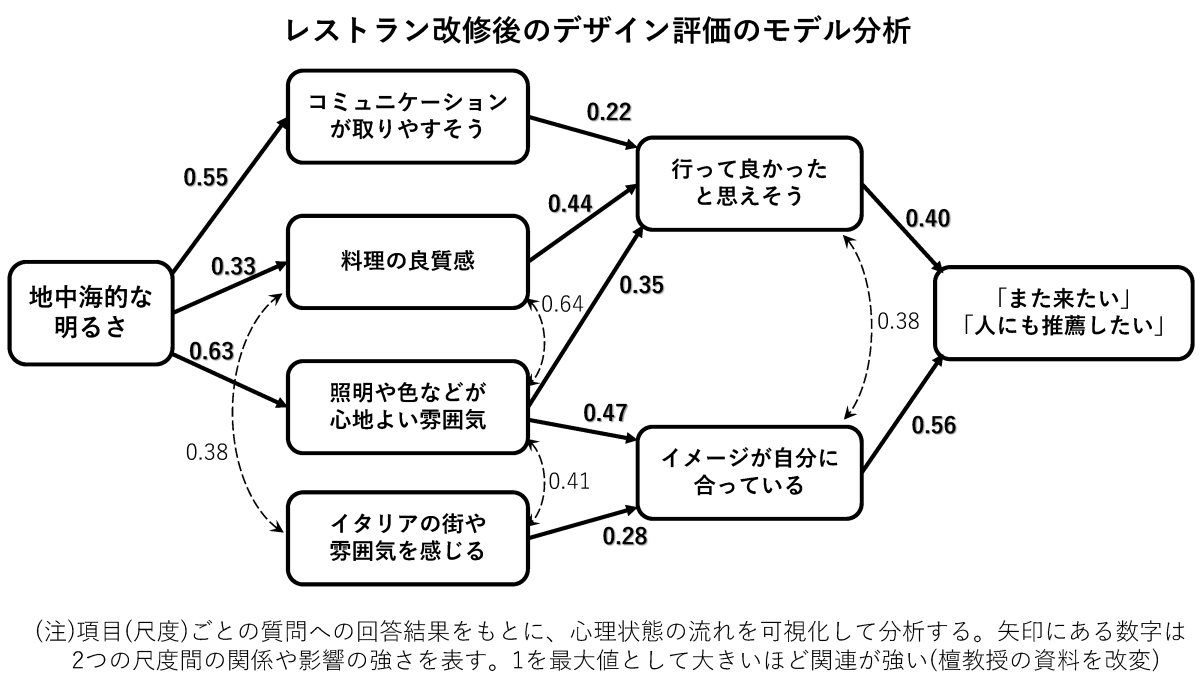
社員が独立した研究者として成長できている、
自前で研究、調査、工夫ができる強み
Employees can grow as independent researchers, and can independently engage in research, surveys, and modifications
——「サイゼリヤ食認知科学研究ユニット」はどのような体制になっていますか? サイゼリヤの社員は何人いるか、檀先生の学生は何人参加しているかなど教えてください。
Q: How is the Saizeriya Food Cognitive Science Research Unit structured? How many Saizeriya employees are there and how many are Prof. Dan’s students?
小川:現在サイゼリヤからは7人参加しています。これまでの累計は十数人になります。
Ogawa: Currently, seven Saizeriya employees are participating in the project. Overall, around a dozen people have participated to date.
檀:サイコメトリクスの部分に関して言えば、学生の関与はほぼありません。これはかなり特殊で、サイゼリヤの研究員だけで全部できているんです。研究者としてのレベルが高く、コミュニケーションもうまくできています。企業との共同研究というと、大学側は受託のような印象があるかもしれませんが、サイゼリヤの場合、我々は教育コンサルティングのような立場でサイゼリヤの研究員をサポートしています。
Dan: When it comes to psychometrics, there is almost no student involvement. It’s quite distinctive that everything is done by Saizeriya researchers. They are high-level researchers with good communication skills. In joint corporate projects, some people believe the research is being outsourced to the university, but with Saizeriya, we provide support for their researchers in a role that is similar to an educational consultant.
——最初からそのような関係を意識していたのですか?
Q: Did you have this kind of a relationship in mind from the beginning?
小川:最初に檀先生にお会いしたときに、企業と共同研究する上で望ましい関係について2つお話をしました。
Ogawa: When I first met Prof. Dan, we discussed two types of relationships that would be desirable in a joint corporate research project.
1つは、企業も大学もwin-winの関係にしたいことです。我々が単にテーマを渡してアウトプットをいただく委託研究ではなく、社員も成長できることを理想にしました。我々にはニーズがあってテーマを提供でき、大学は学会発表や論文などの実績を作ることができるという、お互いにメリットのある関係で平等に進めてきたのが、現在までに関係が続いている理由だと思います。
The first is that we wanted a win-win relationship for both the company and the university. The ideal is to have our employees grow, and not just outsource research on a theme and receive the output. We have been able to propose themes based on their needs, and at the same time the university can generate a track record through conference presentations and journal articles. I believe that the fact that this mutually beneficial relationship proceeds in an equal manner is why our partnership has lasted so long.
檀:サイゼリヤの研究員はサイコメトリクスを原理からわかっているので、他の課題に応用するためにチューニングできます。これを、他の調査会社に外注すると仕組みがブラックボックスのままになってしまい、工夫のしようがありません。サイコメトリクスを身につけ、自前で調査・工夫できるようになっているのは大きな強みだと思います。
Dan: Since Saizeriya researchers understand psychometrics down to its basic principles, they can fine-tune the techniques to apply them in other tasks. If they outsourced the work to another survey company, the mechanism would remain in a black box, and they would have no way to work with it. I think learning psychometrics and being able to implement surveys and modifications on your own is an incredible strength.
——共同研究する上でのもう1つのポイントは何でしょうか?
Q: What is the other important point in joint research?
小川:会社のトップとつながっていて社内の意思決定を早くすることです。サイゼリヤ食認知科学研究ユニットから会社にいろいろな提案をする際、スムーズに進めてほしいという要望がありました。この点については、私の所属する研究開発部は社長直属の部署なので問題ありませんと答えました。
Ogawa: It’s about connecting with the company’s top management and accelerating internal decision-making. When the Saizeriya Food Cognitive Science Research Unit presented its proposals to the company, they asked us to make sure that things would proceed smoothly. I told them this wouldn’t be a problem because the R&D department to which I belong reports directly to the company president.
檀:社長直轄の部署との共同研究はすごくやりやすいです。意思決定までにいくつもの部署の承認が必要だと、途中で頓挫してしまう場合もあります。
Dan: It’s very easy to carry out joint research with a department that is under the direct control of the president. A project might end up in a deadlock if an approval needs to be obtained from multiple departments before making a decision.
小川:もちろんすべての提案が通るわけではありませんが、研究開発部の考えを直接社長に伝えられる場があるのはいい環境だと思います。
Ogawa: Of course, not all proposals are accepted, but we have a good environment where the R&D department can communicate its ideas directly to the president.
——共同研究が10年以上続いているのは珍しいと思います。続けるためのコツがあれば教えてください。
Q: It seems unusual for a joint research project to last for more than 10 years. What have been the tricks to that success?
小川:テーマアップだと思います。例えば、顧客ロイヤルティをやりながら、これはどうだろう、あれはどうだろうと枝葉のように分かれ、それがまた幹になることもあります。会社に適切なニーズがあり、それに対して大学が教育リソースを継続的に提供していただくことがコツです。
Ogawa: I think it’s because our research themes are always evolving. For example, while we are studying customer loyalty, we ask questions about this and that, which creates different branches and leaves of inquiry, which themselves can turn into the main trunk. The trick is for the company to have suitable needs and for the university to continue to provide educational resources.
もう1つは、一区切りついたら必ずレポートとしてまとめていることです。論文ではないのですが、生データも含めてすべてが収まっているものです。他の人が見ても、過去のデータをすべて掘り起こして全部再現できるレベルにまとまっています。
Another thing is that every time we come to a stopping point, we compile a report. This is not an academic article, but it contains everything, including the raw data. It is organized to a level where someone else who looked at it could take all the old data and reproduce the findings.
檀:ここまで生データをたどれるのはサイゼリヤくらいです。それが貴重なリソースとなっています。
Dan: Only Saizeriya is able to follow the raw data to this extent. That is a valuable resource.
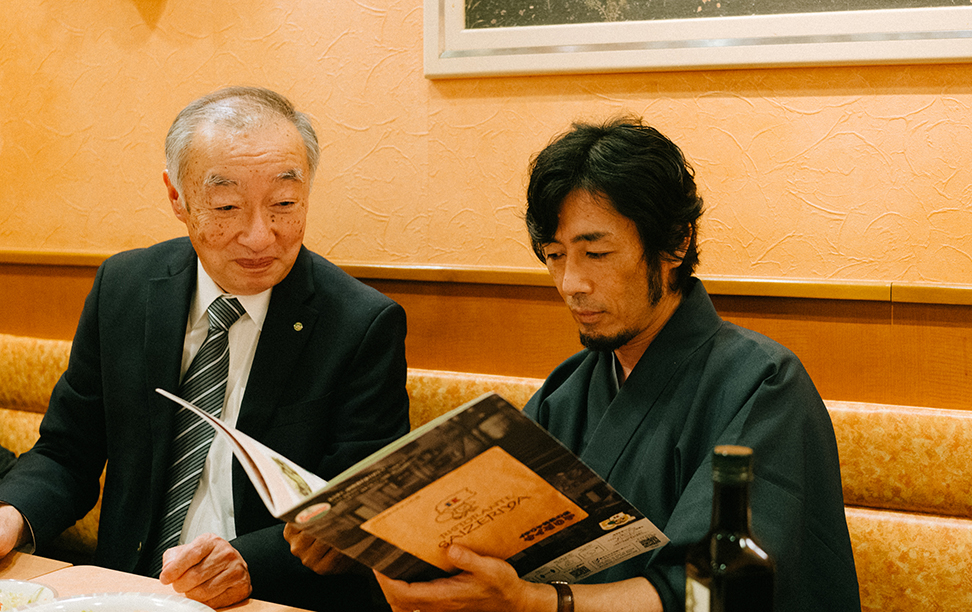
科学的根拠をもとに成長したいサイゼリヤと、
社会インフラとしてのサイゼリヤに貢献したい檀教授
Saizeriya wants growth based on scientific evidence; Prof. Dan wants to aid Saizeriya as a form of social infrastructure
——共同研究を始めてから約10年。これからはどのような研究に取り組んでいく予定ですか?
Q: It has been about 10 years since the joint research project was launched. What kind of research have you planned for the future?
檀:10年前ではできなかった脳の解析ができるようになっています。当研究室では機能的近赤外分光分析法(fNIRS)による脳機能イメージングを用いて脳活動を測定しています。これを応用して、サイゼリヤにおける店内の雰囲気や美味しさの直感がわかるかもしれません。
Dan: We are now able to analyze the brain in ways that were not possible 10 years ago. Our laboratory measures brain activity using functional near-infrared spectroscopy (fNIRS), which is a form of functional brain imaging. By applying this, we can understand people’s gut feelings about Saizeriya’s flavors and the atmosphere inside its restaurants.
小川:もう一つ、現在取り組んでいる研究テーマが、従業員満足度です。心理尺度がわかってきたので、これから活用しようとしているところです。
Ogawa: Another research theme we’re currently working on is employee satisfaction. Now that we have an understanding of psychological scales, we are starting to apply them to it.
檀:従業員満足度の研究はすごくレベルが高く、すでに国際学会で発表しています。近いうちに論文を発表しようと考えています。
Dan: The research on employee satisfaction is very high level and has already been presented at international conferences. We’re thinking of publishing a paper on it in the near future.
——企業との共同研究によって論文数の実績が増える、ということですね。
Q: You mean the number of papers will increase through joint corporate research?
檀:ただ私の場合は、あまり論文数にはこだわっていません。それでも共同研究を続けている理由は、我々の学問がビジネスで必要とされているからです。サイゼリヤは全国に店舗があり、テレビCMを流さなくても多くのお客様が支持しているという意味では、社会インフラともいえます。そのような企業に我々が協力してより良い企業になってくれれば、インフラに対する社会貢献であると考えています。
Dan: As for myself, I don’t really care about the sheer number of papers. Still, one reason we’ve continued to collaborate is that business needs our discipline. Saizeriya has restaurants all over the country and can be considered a form of social infrastructure in that it has the support of a large customer base without having to do TV commercials. If a company improves through a partnership with us, we believe that is a contribution to society’s infrastructure.
小川:会長の言葉に、「食堂業を産業化させる」というものがあります。産業では安定した結果を出すために科学的根拠が必要です。檀先生から教えていただいたサイコメトリクスは、まさにサイゼリヤにおける科学的根拠になっています。
Ogawa: As our chairman says, “We want to industrialize the restaurant business.” Industry needs scientific evidence to produce stable results. The psychometrics Prof. Dan has taught us are creating just this kind of scientific basis for Saizeriya.
——科学的根拠をもとに事業を発展させたいサイゼリヤと、インフラ企業としてのサイゼリヤに社会貢献する檀先生の研究室の目的がうまく一致しているのですね。これからも共同研究が加速し、応用例が増えることを期待しています!
Q: There seems to be a good deal of alignment between Saizeriya, which wants to develop its business based on scientific grounds, and Dr. Dan’s laboratory, which aims to contribute to society through Saizeriya as a kind of infrastructure company. We hope your joint research project will continue to accelerate and look forward to seeing more applications!
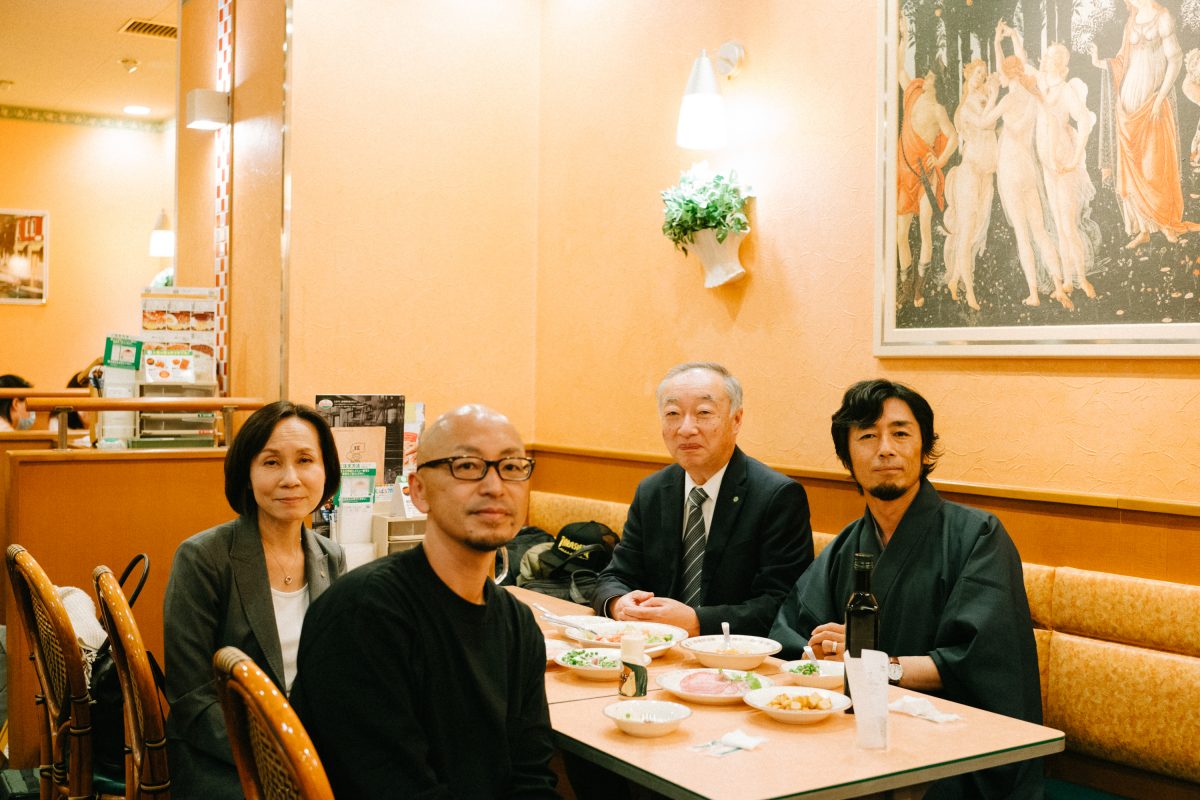
対談は中央大学近くのサイゼリヤにて実施。撮影時以外はマスクをつけて行っています。
From left to right: Ms. Rumiko Ebe of Saizeriya, Associate Professor Yasushi Hisanori of Chuo University’s Research and Development Organization,
Mr. Ogawa, and Professor Dan. The interview was held at Saizeriya near Chuo University. Masks were worn except during filming.
Photographer:Kato Hajime Writer & Editor:島田祥輔
